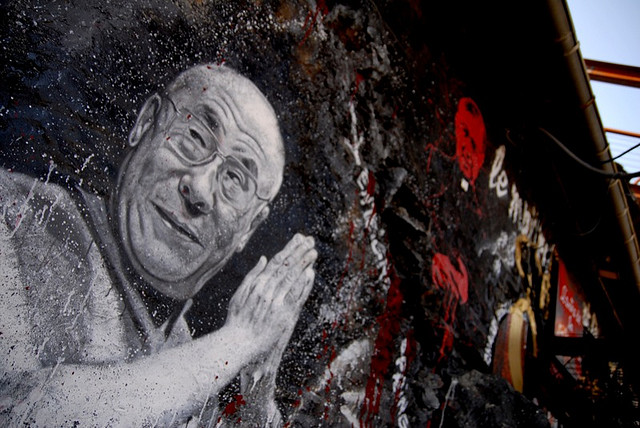As a mediation practitioner who aspires to bring more compassion into this world, I question whether my practice is in my head.
Compassion is easy when I’m not triggered. But what if I or my family were threatened with physical violence?
It’s an important question to ask and it feels like a lose-lose question. If I say I would defend my family with violence, if necessary, then I am told that I am not a pacifist. If I say I would be non-violent at whatever cost, I am met with incredulity that I would sacrifice my family’s lives.
First, I am not a pacifist. I don’t want to even think I could respond according to a philosophy or religion in a moment of fear and life-threatening survival. Secondly, pacifism is not passivism. Non-violence is what I do, not what I don’t do.
I grew up a person of color in a white, working-class, racist town in London. There was a lot of street violence: at best, name-calling, at worst we had stones thrown at us as we were chased out of the park, and some events in between. That’s it. Not too bad compared to some people I knew.
So what saved us?
We were Catholic and we prayed a lot. But I can’t go there. I can’t believe that God heard our prayers but ignores the prayers of others. Maybe luck? But it was confusing at the time because I believed the prayers kind of worked.
What did my parents choose to do in the face of racism? They ran (that time at the park), they didn’t tell the police, and they prayed for a way out. A way did not open so we stayed there for years till the situation eventually improved, thankfully. And then years later, we had the economic upward mobility to remove ourselves from the area.
I know this—when my life is threatened, I do not think. I am an animal and I do whatever I need to do to keep me and my family safe. I perceive no lack of integrity within me—that I would use force if necessary. I also know that we need to prepare ourselves, because otherwise in the face of violence we react with blind fear and in response to the worst stories we weave that may not be grounded in reality. (Just think about what’s motivating all the police officers who shoot at unarmed Black people.) I want to center myself in compassion so that I have a creative arsenal of non-violent strategies that come to me when I am in potentially violent situations because I am practised at going there.
My children are excellent practice. They push me to my edges and I can’t run away. There have been many times I have wanted to hit them. And I don’t. I want to hit them because on some level, I feel threatened. Unmet needs, like choice, autonomy and care, may not appear life-threatening at face value. Yet on an evolutionary psychological level, we experience them as such, especially if those needs were unmet as children in painful and life-threatening ways.
Every morning I practice sitting meditation. I don’t always have the space to sit alone, so my children sometimes cuddle me while I’m meditating, or climb all over me and fight over who gets which leg. I get mad. I just want to meditate. The irony is not lost on me—that I get angry when I’m practising compassion.
But meditation is not a time for me to retreat from the world, it’s practice in orienting myself towards compassion. So I like meditating with them now. I pause before reacting, I notice my feelings, I feel them. I notice if I’m reacting to the thought that “they should allow me to meditate!” I ask myself what I’m longing for. I notice if I’m blaming them for not meeting my needs, and I choose a compassionate response. That choosing is not always an intellectual choice, often it comes to me.
When I learned Non-Violent Communication (NVC), I learned about the protective use of force. This is the minimum force to protect my needs (and those of others, including anyone whose intention might be to harm me). I do not believe that it is violent to do so. On the contrary, it is a consciousness of holding my needs and others’ concurrently, knowing we are inter-connected, rather than reacting to my fear and perceiving them as the enemy.
Non-violence or compassionate consciousness is a way of living in every moment of my life. It is a consciousness that I become familiar with through presence and an awareness of what is going on inside me (mindfulness). Violence is a defensive response to fear and perceived helplessness. If I practice presence with my fears as they arise multiple times every day, I can heal the pain that has caused those fears and bring awareness to my stories. I know that I have choices and am not helpless. In this way, I practice compassion similar to exercising a muscle. I notice when I am reacting, I notice when I am about to react.
We encounter many potentially violent situations. I define “violent” loosely, to mean a power-over/power-under dynamic. For example, most people will choose not to argue with someone whose opinions differ significantly from theirs. This is conflict-avoidant—we want a peaceful life, and it’s a valid choice. A strong debater might choose to engage, especially if they are likely to win, though this is still a power struggle.
How can I engage compassionately with someone who wants war with Iran or who believes that politicians should legislate women’s reproductive rights? By starting with self-compassion: being present with my own fears, that there won’t be change and transformation in the world, perhaps; and then by choosing my response. When we have done sufficient self-compassion and self-empathy (perhaps holding ourselves tenderly for all the times when we haven’t been understood), then we are able to be present with the other with compassion. In this way, we can see them as a person who wants to be heard, wants to be understood, and cares about (certain) people but has chosen a strategy different than we would like to meet those needs. This way feels more empowering than reactionary living.
So how does this relate to physical violence and the original question of, “What is a compassionate response to violence?” I remember a film I saw about Dorothy Day, founder of the Catholic Worker movement. She was in prison and she reached out to a fellow inmate who was in great distress. The woman spat at her. Dorothy did not react, she did not see the woman as a threat, just a soul in a lot of pain. She continued reaching out in compassion.
When we have a heart full of compassion for ourselves, we are naturally able to have compassion for others. “I want to be like that,” I thought (especially as being spat at is a huge trigger for me). But I know that willing myself to be like that is pointless. When triggered, I react with my pain, not with my head or even my better self. I want to invite myself into that compassionate consciousness in all moments of my life. Sometimes all I can do is notice how scared I am and what that feels like, and that is enough. Life happens through me. I open myself to life, and creative strategies emerge.
So what if I or my family were threatened with physical violence? This is all an experiment. Given the safety of my current life, all this musing may just be an indulgence. I don’t know but in this moment and the next, I choose compassion.
Relephant read:
28 Ways to be Kinder, Gentler & More Compassionate.
~
Author: Elizabeth De Sa
Editor: Travis May
Photo: Flickr/Thierry Ehrmann











Read 4 comments and reply